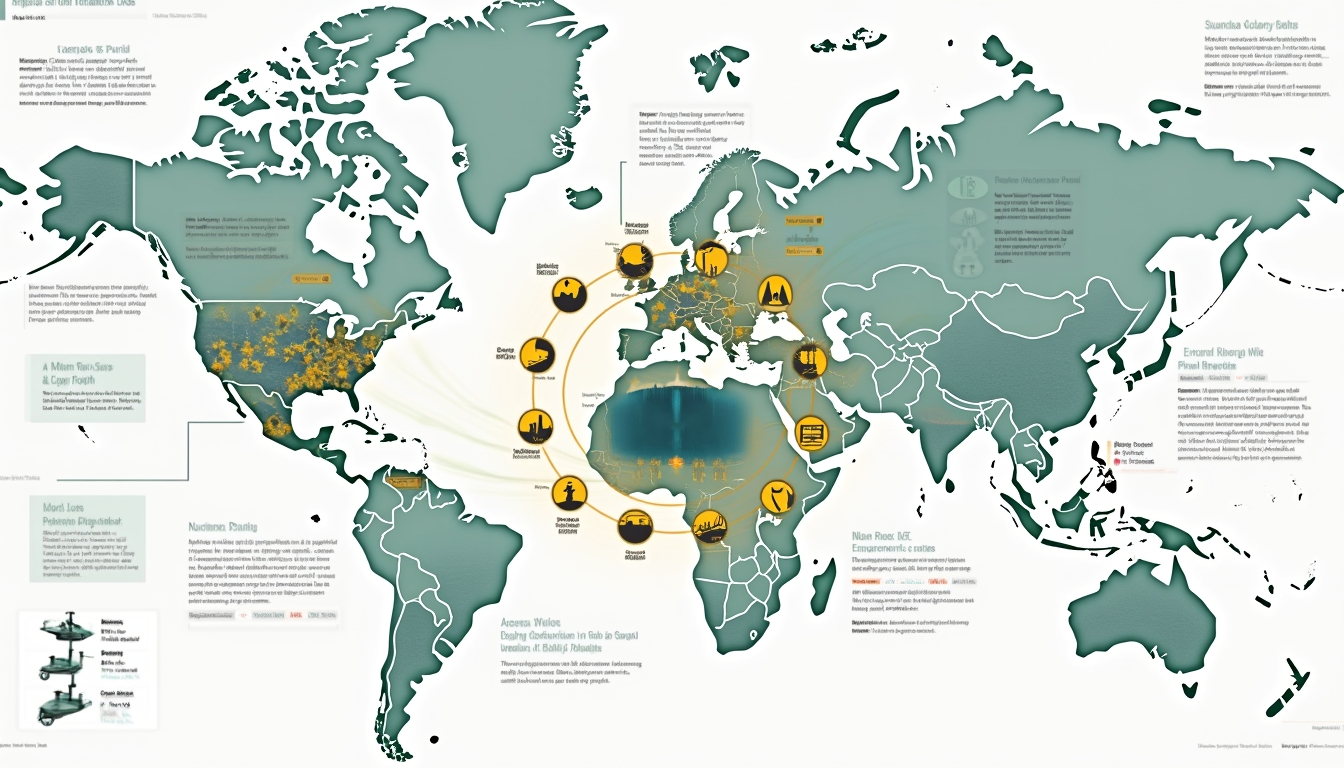Rio Tinto resumes Dampier port operations as part of its robust response strategy following the severe disruptions caused by Tropical Cyclone Sean. The cyclone’s impact on the Pilbara region necessitated quick thinking and innovative risk management techniques, ensuring that the company's commitment to safety, production targets, and environmental sustainability remained intact. This article examines the challenges faced, the recovery measures implemented, and the prospects for the future following this notable incident.
Cyclone Impact and Immediate Responses
Tropical Cyclone Sean swept through Western Australia’s Pilbara region during the peak cyclone season, affecting key mining and shipping operations. The extreme conditions led to significant delays, with flooding and strong winds interrupting rail and port services. As operations were disrupted, there were widespread concerns about operational timelines and shipment schedules, including the temporary halt of shipments at the East Intercourse Island facility. The disruption was comparable to previous events, such as when a severe storm recently cyclone disrupts shipments led to similar challenges in the transportation of iron ore during the first quarter.
In response, Rio Tinto promptly restored essential services at the Dampier port, emphasising its capacity to manage adversity. This swift action resulted in Rio Tinto resuming Dampier port operations sooner than anticipated, which has been crucial in maintaining the supply chain integrity. Moreover, shipping activities resumed effectively at related facilities, with reports from prominent news outlets confirming that the port is fully operational after the cyclone’s disruption. For instance, according to Reuters, shipping operations resumed at the Dampier port shortly after the storm passed.
Recovery Strategy: A Multifaceted Approach
Operational Resilience and Risk Mitigation
The recovery strategy deployed by Rio Tinto incorporated several layers of operational resilience. One of the key aspects was the pre-emptive deployment of advanced weather monitoring systems, allowing for real-time updates and swift action before conditions worsened. Such measures were essential in mitigating anticipated risks that could have further delayed operations.
Additional strategies included the reinforcement of infrastructure and the adjustment of shipping schedules. The operational recovery not only involved meticulous planning but also highlighted the integration of modern technological solutions, such as automated monitoring and predictive modelling. In the context of broader environmental initiatives, the industry has also been exploring ways to tackle scope 3 emissions, further aligning operational resilience with sustainability goals.
Reinstating Production Targets
Despite the logistical challenges, Rio Tinto managed to maintain its iron ore production target of 323-338 million metric tons for 2025. By quickly adapting to the adverse conditions, the company not only minimised the operational downtime at Dampier port but also restored confidence among investors and stakeholders. This recovery was achieved through a combination of robust risk management and strategic planning, underpinning the overall narrative of resilience that has now become synonymous with the company's operations. Moreover, the company's commitment has been further echoed in similar scenarios, such as those observed at nearby port hedland resilient operations.
Integration of Clean Energy Investments
An emerging trend within the mining sector is the focus on decarbonisation and sustainable energy solutions. As part of its broader operational strategy, Rio Tinto has been observed pivoting towards cleaner and more sustainable operations. This shift includes initiatives aimed at boosting copper investments, which complement its renewed shipping operations. By integrating clean energy practices, the company not only supports global sustainability goals but also fosters a positive image among environmentally conscious stakeholders.
Technological Innovations in Extreme Conditions
Mining in cyclone-prone regions such as the Pilbara demands sophisticated technological interventions. Rio Tinto has invested heavily in advanced predictive modelling and automated systems, which have proven crucial in navigating unexpected weather challenges. The use of state-of-the-art monitoring systems allows for near-instantaneous data collection and analysis, which in turn facilitates real-time decision-making during disruptive events.
Furthermore, a sustainable steelmaking pilot reflects the industry’s broader commitment to technological innovation. Projects like these are essential not just for immediate recovery but also for long-term enhancements in process efficiencies and environmental resilience. Such innovations are vital, especially when faced with the dual challenges of maintaining production levels while ensuring environmental and operational safety.
Economic and Market Implications
Global Iron Ore Pricing and Operational Transparency
The temporary suspension of shipments due to Cyclone Sean exerted an influence on global iron ore pricing, albeit momentarily. The recovery of operations at Dampier port helped stabilise the market, but the incident served as a stark reminder of how susceptible global supply chains can be to natural disruptions. Shipping delays and subsequent cost implications underline the importance of resilient and responsive operational strategies.
Transparent communication played a major role in the aftermath of the cyclone. During its first-quarter review, Rio Tinto provided stakeholders with a detailed operational update, ensuring that the market understood the extent of the impact and the measures being undertaken to address it. This level of transparency is essential in maintaining investor confidence and is part of the industry’s broader trend of integrating robust risk management practices with clear, proactive communications.
Broader Economic Considerations
The cyclone's effects were not isolated to production; they also had significant ramifications for:
- Global commodity markets, especially concerning iron ore,
- Local economies reliant on steady shipping schedules and production timelines,
- Stakeholder and investor perception of operational resilience,
- Long-term planning regarding environmental and climate change adaptations.
Investors have taken note of these factors, and positive market reactions following the resumption of Dampier port operations have highlighted the company’s commitment to sustainable excellence and strategic preparedness.
Future Outlook: Adaptive Strategies and Sustainability
Looking forward, the incident has catalysed discussions on enhancing future readiness. Rio Tinto’s methodical response and rapid recovery exemplify how major disruptions can serve as a wake-up call for continuous improvement.
Embracing Environmental Change
It is increasingly evident that the mining industry must remain adaptive in the face of climate change. Key adaptations include:
- Implementing comprehensive risk management frameworks.
- Upgrading infrastructure to withstand extreme weather events.
- Increasing reliance on predictive analytics and automated systems.
- Integrating more sustainable practices, such as incremental decarbonisation measures.
Such initiatives are not only crucial for managing immediate risks but also for ensuring long-term environmental sustainability. They have prompted other industry leaders to review their risk management strategies and consider similar measures that balance productivity with environmental protection.
Strengthening Stakeholder and Community Engagement
The recovery of operations has also drawn attention to the importance of maintaining robust community and stakeholder relationships. By demonstrating a commitment to both operational resilience and environmental responsibility, Rio Tinto has fortified its position as a leader in the mining sector. This commitment is further exemplified by the company’s calculated investments in future technologies and infrastructure improvements, positioning itself as a model for other resource companies in the region.
Continued strategic investments, such as the ongoing shift towards clean energy and the implementation of new logistical frameworks, are expected to further bolster the industry’s resilience. In doing so, the company has laid a strong foundation for future-readiness that will help mitigate the impacts of similar events in years to come.
External reports from reputable sources also praise the resumption efforts, with financial news outlets highlighting how quickly transportation corridors have stabilised at key facilities like the Dampier port. For instance, finance.yahoo.com recently noted that initial disruptions have largely been contained, underpinned by careful planning and prompt action at the port.
Summary: Key Takeaways and Future Directions
The lessons drawn from Cyclone Sean reaffirm the necessity of:
- Investing in resilient infrastructure and risk management systems.
- Maintaining transparent and timely communication with all stakeholders.
- Diversifying operational strategies to include sustainable, clean energy practices.
- Continuously refining technological solutions to swiftly counter environmental challenges.
To summarise:
- Rio Tinto resumed Dampier port operations quickly after Cyclone Sean, ensuring that production targets remain intact.
- The company’s multifaceted recovery strategy combined predictive monitoring, infrastructure reinforcement, and sustainable initiatives.
- Global market stability was maintained, thanks to transparent communication and rapid operational recovery.
- Long-term investments in clean energy and technological innovations are paving the way for even greater resilience in the face of future challenges.
By strategically addressing both immediate and long-term operational challenges, Rio Tinto continues to set a benchmark for excellence in the mining sector. Notably, the company has affirmed that Rio Tinto resumes Dampier port operations as an example of resilient leadership, having successfully navigated one of the most disruptive weather events in recent history. This incident reinforces the fundamental importance of adaptability, technological innovation, and proactive stakeholder engagement in sustaining operational continuity and market confidence.
Want to Stay Ahead in Mining Investments?
Discover real-time insights into significant mineral discoveries with Discovery Alert's AI-powered notifications, which simplify complex ASX announcements and help investors—from beginners to seasoned traders—capitalize on emerging opportunities in the mining sector. Start your 30-day free trial today and transform how you approach mineral investing.







